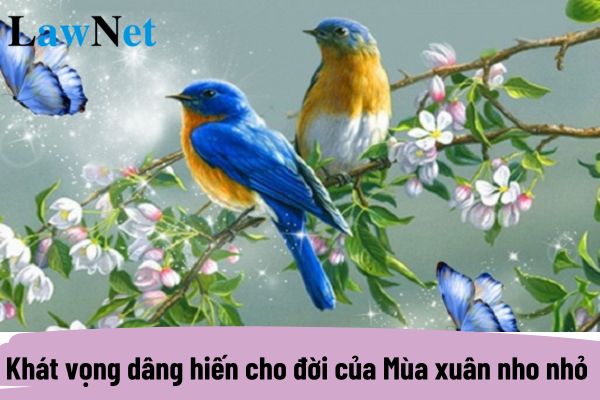Vietnam: What is the aspiration to contribute to life in the poem "Mùa xuân nho nhỏ"? What are the requirements for the 9th-grade Literature curriculum?
What is the aspiration to contribute to life in the poem "Mùa xuân nho nhỏ"?
The poem "Mùa xuân nho nhỏ" by Thanh Hai is a sweet love song dedicated to life and the nation. In this work, the poet's aspiration to contribute to life is expressed profoundly and elegantly.
The aspiration to contribute to life in the poem "Mùa xuân nho nhỏ" is included in the 9th-grade Literature curriculum as follows:
|
Aspiration to contribute to life in the poem "Mùa xuân nho nhỏ"
|
*Note: Information about the aspiration to contribute to life in the poem "Mùa xuân nho nhỏ" is for reference only./.

What is the aspiration to contribute to life in the poem "Mùa xuân nho nhỏ"? What are the requirements for the 9th-grade Literature curriculum? (Image from the Internet)
What are the requirements for the 9th-grade Literature curriculum in Vietnam?
Under Article 31 of the Law on Education 2019, the 9th-grade Literature curriculum must meet the following requirements:
- Reflect the objectives of general education;
- Concretize the requirements on the outcomes of students’ quality and capacity after each educational level and on the educational contents compulsory to all students throughout the country;
- Concretize the requirements on the methods and forms of organizing educational activities and on the evaluation of educational outcomes for subjects of each class and educational level of general education.
- Be consistent throughout the country and implemented flexibly, suitable with specific conditions of localities and institutions of general education;
- Be open to feedbacks from organisations and individuals and undergo a pilot implementation before promulgation; be publicly announced after promulgation.
Who will decide the selection of 9th-grade Literature textbooks for use in the locality in Vietnam?
According to Clause 1, Article 32 of the Law on Education 2019:
1. Textbooks of general education are regulated as follows:
a) Textbooks must implement programmes of general education, concretizing the requirements on educational objectives and contents, on students’ quality and capacity as defined in programmes of general education; direct teaching methods and methods of assessing and evaluating education quality; contents and formats of textbooks shall not carry prejudices based on ethnicity, religion, profession, gender, age and social status; textbooks may be in the printed, Braille or electronic forms.
b) Each subject shall have one or several textbooks; implement private sector involvement in textbook compilation; textbook publication shall be in compliance with the law;
c) Provincial People’s Committees shall decide selection of textbooks for consistent use in institutions of general education in their localities as regulated by the Minister of Education and Training.
d) Local educational materials shall be designed by provincial People’s Committees to meet the needs and characteristics of their localities, be appraised by provincial review councils for appraising and approved by the Minister of Education and Training.
The Provincial People’s Committees shall decide the selection of textbooks for consistent use in institutions of general education in their localities as regulated by the Minister of Education and Training.

